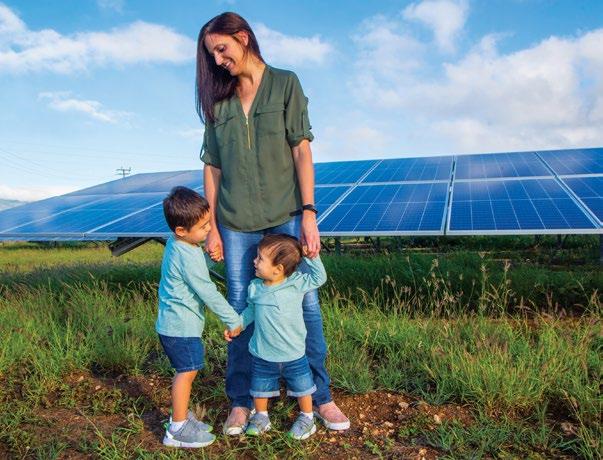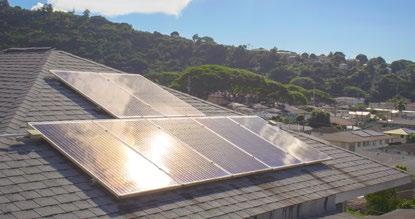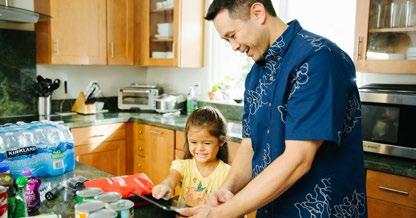
10 minute read
Our Customers
We are deeply rooted in our communities and take pride in serving our customers, our extended ‘ohana (family). Our primary customer service goal is to create positive and meaningful experiences, making it easy to do business with us. We understand that addressing the needs of our customers is key to delivering value, and our strategy relies on continuous evaluation and improvement so we can evolve as a customer-centric, community-focused organization.
Advertisement
Energy Affordability
2 5
Energy affordability is a key priority for us given the high cost of living in our state. With limited land, real estate values are high. Almost all materials and goods must be shipped into the state. These factors increase the cost of everything from housing to groceries. According to the U.S. Bureau of Economic Analysis, in 2019 Hawai‘i had the country’s highest “all items regional price parity,” a measure of cost of living that reflects the price of goods and services, such as food, transportation and education, as well as housing rents, compared to a national baseline price level.
Electricity prices in Hawai‘i are among the highest in the nation,4 due in part to the cost of imported oil used to power many of the islands' generators. In 2020, fuel and purchased energy costs comprised approximately 40% of a typical residential customer bill on O‘ahu, and fuel costs fluctuate significantly depending on international oil market prices. Our isolated geographic location also contributes to the higher cost of electricity. Each island grid must operate a standalone system, unable to draw power from other islands or the mainland if needed. As such, system reliability requires that we have reserve generating capacity and multiple distribution routes.
4 However, Hawai‘i’s average residential electricity bills are helped by lower-than-average electricity usage. Based on monthly household kWh sales data from the U.S. Energy Information Administration, the average Hawai‘i home used 40% less electricity than the national average.
Increasing Efficiency and Delivering Savings
2
We’re striving to be a highly efficient utility. Our new PBR framework includes strong incentives for cost efficiency. In addition, in recognition of the financial challenges our customers faced due to the COVID-19 pandemic, in 2020 we proposed, and the PUC approved, holding base rates flat in our O‘ahu 2020 rate case. In connection with a management audit conducted as part of the rate case, we committed to ramp up to $25 million in annual savings by year-end 2022. In 2021 we agreed to an acceleration of these audit savings, with $6.6 million to be delivered to customers per year from 2021-25.
To offset the lack of a base rate increase, achieve our customer savings commitment and operate within the PBR structure, we’re implementing plans to reduce costs through improved planning and scheduling of work leading to reduced overtime, managing the size of our workforce, continuing our process improvement initiatives, strategic sourcing of goods and services and reducing our office footprint. In 2020 our efforts resulted in significant customer savings, including $7 million in operations and maintenance savings. We also achieved the savings we committed to deliver to customers in connection with our Enterprise Resource Planning (ERP) system.
Transitioning Away from Volatile Fossil Fuels to Fixed-Price Renewables 1 2
Substituting fixed-price, lower-cost renewable energy resources for fossil fuel-based generation is the best opportunity to provide customers with lower and more stable electric rates. This renewable energy transition can also drive savings in other sectors (e.g., lowering costs of operating electric vehicles).
Innovating Renewable Energy Contracts that Provide a Win-Win-Win
We continue to innovate new contracting mechanisms that reduce costs for developers, helping lower costs for customers and facilitating attainment of our RPS goals. We developed a new model power purchase agreement, the Renewable Dispatchable Generation Power Purchase Agreement (“RDG PPA”), which enables the utility to dispatch variable renewable projects to match the needs of the grid. In exchange for making the facility dispatchable, project owners receive a fixed monthly payment. This predictable income stream reduces financing costs for developers and results in lower prices for our customers. Our recent renewable procurements have yielded project pricing with an average price of 10 cents per kWh for solar plus storage projects, below the cost of utility oil-fired generation. The RDG PPA has been cited as a “game changer.”5
Helping Customers Manage Their Usage and Bills 2 5
The company offers a range of programs to assist customers in managing their energy use and bills:
LIHEAP (Low Income Home Energy Assistance Program) that provides qualifying low-income households a one-time credit to offset energy costs. As part of this program, in 2020 we helped more than 8,000 families receive $3.9 million in energy assistance.
The Hawai‘i Green Infrastructure Authority (HGIA)
Green Energy Money $aver (GEM$) On-Bill Program
helps customers reduce electricity costs by installing energy improvements such as rooftop solar, solar hot water systems and/or commercial energy efficiency retrofits, which are repaid through the customer's electric bill.
The Special Medical Needs program is designed to provide reduced electricity rates for qualified customers who are dependent on life-support equipment used in their homes and/or have increased heating and cooling needs due to their medical conditions.
We also partner with nonprofits who provide utility payment assistance and connect our customers with nonprofits for help.
In light of the economic impact COVID-19 has had on our customers:
We voluntarily suspended disconnections for nonpayment beginning in March 2020; the PUC has extended disconnection suspensions for all utilities in
Hawai‘i through end of May 2021.
We’re offering flexible payment arrangements and helping customers access public assistance, including federal stimulus programs, to help reduce their outstanding balance.
We were the founding sponsor of a program to help families throughout the state struggling from the impacts of the pandemic pay bills for electric, water, sewer and gas utilities.
Enabling Distributed Energy Resources (DER) 1 2 5
In the past, electricity generation took place only at large-scale, centralized power plants. Distributed energy resources, or DER, refers to smaller generators and storage devices located throughout the energy grid, such as rooftop solar on customers’ homes and businesses, customer-sited energy storage, electric vehicles that store and use electricity, and demand response devices like grid-interactive water heaters, which can be turned off during system peak usage.
Our DER strategy is anchored by 3 three principles:
Need. Customer-sited distributed energy resources are essential to achieving our 100% renewable energy goal.
Opportunity. The utility must expand opportunities for costeffective distributed energy resources.
Equity. The expansion of distributed energy resources must benefit all customers.
Affordability and equity are central to our DER strategies. We’re committed to integrating distributed generation with fair pricing for all customers. With among the highest rates of rooftop solar adoption in the U.S., we have identified a critical opportunity to ensure prices remain fair as we push for further DER adoption.
We are working to ensure customers without DER are not subsidizing customers with DER. While we want to encourage DER adoption, there are valid reasons why some customers might not be able to access DER (e.g., renters, properties without appropriate roofs, upfront cost structure), and we are determined to make sure those customers are not paying more than their fair share. This means customers with DER fairly contribute to the fixed costs of operating the electric grid on which they depend, often daily, for electricity when their system is not producing, while at the same time DER customers are fairly compensated for the services they provide to the grid.
To promote fair pricing we have implemented several programs for customers who would like to offset their energy bill by investing in clean energy generation, including Customer GridSupply Plus and Smart Export (these programs compensate customers for exporting energy to the grid at prices that place less burden on non-DER customers). Net Energy Metering, which compensated customers at the full retail rate, was closed to new participants in 2015. We’re developing new DER tariffs and programs to benefit all customers. For example, we’re expanding our CommunityBased Renewable Energy program and have proposed a rooftop rental program in which customers get paid by the utility to rent their roof for DER systems that can provide benefits to the entire system. We have procured aggregated grid services from customer DERs, which provide additional economic benefits to DER customers while providing cost-effective ancillary services that benefit all customers.
More than ever, equity is important to us. It is our obligation to provide solutions that work for all, so that everyone has access to affordable, reliable, clean energy. Solutions that work for “most” are not sufficient if they do not address the needs of those who face the challenges. Whether considering issues of project siting, rate design, or community resilience, we’re committed to leveraging Hawai‘i’s renewable transition to address societal inequities.

Advanced Rate Design
2 5
We are also developing advanced rate options, including costbased price signals designed to reward customers for efficient use of electricity and deployment of DERs. Our Advanced Rate Design Strategy (ARDS), submitted to the PUC in 2019, focuses on pricing and programs that enable customers to better manage their electricity use. Well-designed rates should do one or more of the following:
Promote customer engagement
Promote affordable customer bills aligned with system costs
Support low-income customer options
Advance and sustain progress on clean energy, including acquisition, integration and utilization of distributed energy resources
Support electrification of transportation
Fairly allocate costs
Promoting Customer Satisfaction
We strive to improve customer satisfaction by increasing service accessibility and improving customer service quality at all points of engagement.
Over the past five years we improved customer service by creating online and mobile options. Our Online Customer Service Center enables customers to pay bills, start / stop service and update their account. By the end of 2020, 24% of our customers had signed up for paperless billing. Our mobile app allows O‘ahu customers to pay bills, start / stop service, report and get updates on power outages and receive alerts. Our interactive EV charger map allows customers to find detailed information on our EV fast charging stations.
To stay in touch with our customers and their needs, we conduct quarterly residential customer satisfaction surveys, which are benchmarked against 99 other utilities across the nation.
We have made significant strides in improving customer satisfaction. Our 2020 consolidated overall satisfaction score of 74 represents a 25% increase since the start of our 2015-2020 strategic plan. We take pride in this improvement as a reflection of our customer-centered strategies.

Our Service Standard
We will be safe, courteous, professional and efficient as we serve you, and earn your trust. To do so, we will:
Treat you as a member of our ‘ohana
Respond promptly with respect and empathy
Understand and listen to your needs and perspectives
Share information clearly and concisely
Take ownership and keep our commitments
End-Use Efficiency & Demand
1 2 5
Energy efficiency helps customers save money, reduces overall demand, may reduce the need for more generation facilities, and helps preserve our environment.
In Hawai‘i, all electric utility customers pay a public benefits fee (PBF) that funds demand-side reduction and energy efficiency initiatives. Under current Hawai‘i law, a public utility cannot administer such programs or use PBF surcharge funds. The PUC contracts a third party known as Hawai‘i Energy to administer programs that support energy efficiency, clean energy technology, demand-side management (DSM) and energy conservation services and products.
We encourage the efficient use of energy through online customer education tools. In addition, where permitted, Hawaiian Electric and Hawai‘i Energy work in partnership on projects and customer education. In its PBR decision the PUC encouraged collaboration between the utility and Hawai‘i Energy with respect to increasing low- to moderate-income customer energy efficiency, establishing a financial incentive for the utility for such collaboration. Additionally, Hawaiian Electric provides energy efficiency and ENERGY STAR® information in our customer education resources and refers customers to Hawai‘i Energy for programs and services whenever possible.
At Hawaiian Electric we participate in a range of activities to educate customers on energy efficiency, energy conservation, demand response and technologies such as advanced meters and electric vehicles. These activities help customers manage their energy usage and make informed decisions that maximize their electric bill savings. These educational initiatives are implemented through workshops, community events and informational material. We provide educational material online, via social media and in printed versions in multiple languages to reach our diverse customer base. We also help educate students by providing educators free material on basic electricity, energy conservation and efficiency, renewable energy and electrical safety.











